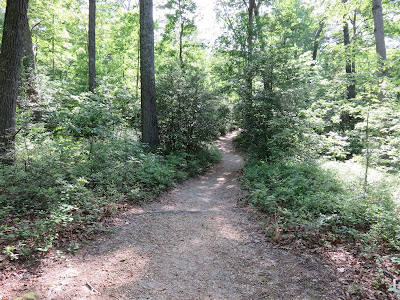Between the visitor center and the battlefield, a few trees rise from a blanket of pine needles and look out over the rolling, emerald field to the dense forest beyond. Two solitary cannons remain among the trees, which appear to stand guard over these wrought iron and wooden-wheeled structures as if they are aware of their significance and of the role they played in the battle.
To the far side of the battlefield, a dense forest harbors the remains of trenches and other fortifications where so many soldiers fought and lost their lives. Dirt trails and a paved tour road cut through the shadowy forest and wind around these fortifications, and if you venture onto them, you will find yourself surrounded by a variety of trees, plants, and shrubs. However, a short distance into the forest, you may begin to feel as if someone is standing among the foliage, watching you as you pass. The deeper into the forest you get, the more intense the feeling becomes. Perhaps the soldier spirits that nearby residents see on the battlefields at night are simply curious about the living who have come to walk the trails.
If any battlefield could have the reputation of being haunted, it is Cold Harbor. The Battle of Cold Harbor is described as one of the bloodiest and lopsided battles of the war. Approximately 108,000 Union soldiers and 62,000 Confederates engaged in the thirteen-day battle. Over 1,800 Union troops were killed, while the Confederates suffered significantly less casualties, with only 83 killed.
The official website for the Civil War Trust, at www.civilwar.org, describes the battle at Cold Harbor in the following way:
On May 31, Maj. General Sheridan's cavalry seized the vital crossroads of Old Cold
Harbor. The following morning, Sheridan was able to repulse an attempted reposses-
sion by Confederate infantry. Confederate reinforcements soon arrived and clashed
with the Union Sixth and Eighteenth Corps when they reached Cold Harbor that
evening. By June 2, the armies had formed a seven-mile front that extended from
Bethesda Church to the Chickahominy River. General Grant was poised for a major
assault to General Lee's right flank and cut off the Confederates off from Richmond,
but when Maj. General Hancock's Second Corps arrived after midnight march, too
fatigued to support the Union left flank, the operation was postponed until the
following day. This fatal delay gave Lee's troops time to build an impressive line of
trenches. At dawn June 3, the Union Second, Sixth, and Eighteenth Corps, followed
later by the Fifth and Ninth Corps, assaulted along the Bethesda Church-Cold Harbor
line and were slaughtered at all points. Grant pulled out of Cold Harbor after nine
days of trench warfare and continued to try to flank Lee's army at Petersburg. Grant
later expressed remorse for the egregious Union casualties at Cold Harbor, stating,
"I have always regretted that the last assault at Cold Harbor was ever made [...] no
advantage whatever was gained to compensate for the heavy loss we sustained."
On the 151st anniversary of the battle, the National Park Service hosted events at the battlefield to provide visitors with information about the battle and its aftermath. Jeff Santos and I were among the visitors at this event. We spent the day walking the trails through the forest, hoping to catch a glimpse of who- or whatever seemed to be watching us as we ventured deep into the forest.
In addition to the unseen onlookers, we also came upon encampments of reenactors. The white, angular forms of their canvas tents were a stark contrast to the emerald forest surrounding them, and the smoke from campfires rose up to the canopy of the trees, filling it with an eerie, blue-gray haze. The reenactors stood cleaning their muskets, or sat upon rough wooden benches as they enjoyed their lunches. They were friendly and informative, and willing to endure our relentless camera flashes and video clips.
The finale of the two-day event was a luminary tour, in which visitors were guided on a walking tour past actors who provided a glimpse into the reality of life as a Civil War soldier. The paved road that stretches from the battlefield and into the forest was lined with white paper bags illuminated by LED lights. The road ended at another field, far more secluded than the first, that was filled with the same white bags. The LEDs and the bags that contained them cast off an unearthly, bluish-white glow in the blackness of the surrounding forest.
We tagged along at the back of our tour group as we made our way along, snapping pictures at anything and everything, even into the shadow-filled forest that flanked the tour road. At the end of the road, the entire group took turns taking pictures of the field full of luminaries with the gibbous moon hanging high above it.
When satisfied with the pictures we'd taken, we turned an made our way back down the road to the visitor center. And as we rounded a gentle curve in the road, I happened to glance off the side of the road to my left. My breath caught in my throat. Standing in the tree line, beyond the reach of the luminary glow, atop a small hill beside a trench, were two grey figures leaning against a tree. They were as silent as death, and simply stared back at us as we passed. I lifted my camera and snapped a picture of them before continuing onward. It's possible that they were reenactors who'd emerged from the forest, as curious about us as the unseen onlooker from the trails earlier in the day. However, it's also possible that they were the spirits of two soldiers killed during the battle, perhaps standing beside the trench where they lost their lives. There's no way to be certain.
by Linda Cassada
Virginia Paranormal Investigations










